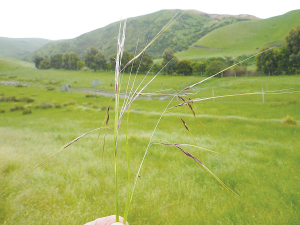NZ scientists make breakthrough in Facial Eczema research
A significant breakthrough in understanding facial eczema (FE) in livestock brings New Zealand closer to reducing the disease’s devastating impact on farmers, animals, and rural communities.
 Chilean needle grass has sharp penetrating seeds that cause blindness in livestock, pelt and carcass damage – as well as the loss in pasture quality and grazing.
Chilean needle grass has sharp penetrating seeds that cause blindness in livestock, pelt and carcass damage – as well as the loss in pasture quality and grazing.
If nothing was done to stop Chilean needle grass, it could spread through most of New Zealand and eventually cost the country over a billion dollars.
That predication comes following newly published research.
The potential 'sleeper weed' Chilean needle grass (Nassella neesiana) is known to have already taken hold in Hawke's Bay, Canterbury, and Marlborough. It has sharp penetrating seeds that cause blindness in livestock, pelt and carcass damage - as well as the loss in pasture quality and grazing access leading to farm production to take a financial hit.
This weed is one of approximately 22,000 species of introduced plants in New Zealand. The scientific challenge is to identify those that pose an economic or environmental threat before they become widespread.
These sleeper weeds can then be prioritised by authorities – such as regional councils and the Department of Conservation for management to prevent their spread.
“The exciting part is that we now have the ability – through our research – to develop models and tools to identify sleeper weeds,” says AgResearch principal scientist Dr Graeme Bourdôt.
“And predict how and where they will spread in a changing climate and estimate the economic and environmental damage that would result.”
He adds that AgResearch has worked with Manaaki Whenua - Landcare Research on analysing various management scenarios for sleeper pests in general.
“We are currently working with regional councils, DOC and the Ministry of Primary Industries to develop a web-based tool that will enable informed decisions about investing in sleeper weed management programmes”.
The newly published research about Chilean needle grass is in the science journal PLOS One, authored by Bourdôt and AgResearch colleague Dr Chris Buddenhagen. The research combined climate niche modelling (to estimate the potential range of the species in New Zealand) and a spread model (to estimate the future economic losses under a “do nothing” scenario) to determine the benefits of stopping its spread.
Under realistic low and high estimates of this weed’s spread rate, where it takes either 201 or 100 years to reach 90% occupation of its potential climatically suitable range covering 3.96 million hectares, the loss to the pastoral sector is $192 million and $1.16 billion respectively.
These losses would justify annual expenditures to prevent the spread of $5.3m and $34m respectively, the research claims.
“This bio-economic modelling reveals that a nationally coordinated approach to managing Chilean needle grass makes best economic sense,” Buddenhagen says.
“This would include surveillance in susceptible regions and control measures in the infested regions.”
The National Wild Goat Hunting Competition has removed 33,418 wild goats over the past three years.
New Zealand needs a new healthcare model to address rising rates of obesity in rural communities, with the current system leaving many patients unable to access effective treatment or long-term support, warn GPs.
Southland farmers are being urged to put safety first, following a spike in tip offs about risky handling of wind-damaged trees
Third-generation Ashburton dairy farmers TJ and Mark Stewart are no strangers to adapting and evolving.
When American retail giant Cosco came to audit Open Country Dairy’s new butter plant at the Waharoa site and give the green light to supply their American stores, they allowed themselves a week for the exercise.
Fonterra chair Peter McBride says the divestment of Mainland Group is their last significant asset sale and signals the end of structural changes.

OPINION: Your old mate welcomes the proposed changes to local government but notes it drew responses that ranged from the reasonable…
OPINION: A press release from the oxygen thieves running the hot air symposium on climate change, known as COP30, grabbed your…